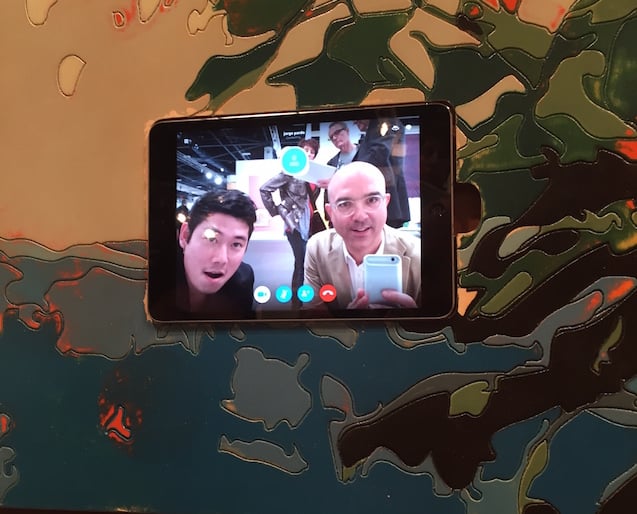
Photo Brian Boucher.
You might easily walk by one of the more engaging artworks at Art Basel in Miami Beach.
A colorful painting by Jorge Pardo on offer from New York’s Petzel Gallery contains, in its lower right corner, a small niche for an iPad. The colorful, stylized image shows Pardo reaching the bottom of a water slide at an amusement park, based on a photo taken by his daughter.
This isn’t some 20-something Post-Internet artist’s attempt to reconcile the physical and the digital, though. Rather, the iPad allows you to Skype with the artist.
The gallery’s Ko Sadakuni set up an appointment for me to chat with Pardo during the preview day at the fair on Wednesday. We rang him several times and got no answer. I wandered off, but Sadakuni then ran to where I was standing nearby. “We got him!”
As usually happens with these things, Sadakuni then had to make several attempts to get the connection working right. We could see Pardo but there was no sound.
“Can you hear me?” Sadakuni said. “I can’t hear you. Is your mike on? … No, now you’ve just changed the view to panorama. I can see your washing machine behind you now, though.” Laughs.
We tried headphones after pulling the iPad out from where it was velcroed into its niche. No go.
Finally he got the sound to function, and I pulled up a chair and briefly interviewed the jovial artist, who sports a bushy white beard and was sitting at his place in Brooklyn. Apparently, judging by the laundry machines, he was in the utility room.
“I wanted to make a painting you could speak through,” Pardo told me. “It’s partly a response to the notion that paintings can ‘speak’ to you, which is bullshit. It’s about the reflexivity of inanimate objects.”
The idea of the painting took into account the hectic situation in which it would be shown, he said, in competition with thousands of other works, with buying and selling all around among the tens of thousands in attendance.
“No painting can stand up to the realities of that setting,” he said. “Of course it’s a nice image. There’s nothing wrong with it. But it’s also about one kind of looking as opposed to another.”
At that point, New York artist Rainer Ganahl interrupted for a quick chat with the artist, suggesting that they get together when Ganahl was back in Brooklyn.
“Now, what’s your e-mail address, again?” Ganahl asked, and Pardo shared his AOL address with him.
Jorge Pardo’s painting, with iPad.
Photo Ko Sadakuni.
Galerie Neugerriemschneider’s Pardo-designed booth was one of the hits of the fair last year. All the artworks hung on the booth’s exterior, while Pardo furnished the inside as a luxe, low-lit lounge.
What does Pardo think of art fairs?
“I’m not a huge fan,” he confessed, “though I can stomach them just fine. I’m there if I need to be. But it’s amazing that they’ve superseded museums for years now, such that they’ve become the central visual event of the art world. Twenty-five years ago, when a dealer asked you to provide something to bring to a fair, there was always an apology that went with it!”
We soon wrapped up our chat, and a grinning Friedrich Petzel stepped in to check in with the artist before he signed off.
Only then did I realize that a few onlookers had gathered, thrilled to see the conversation in progress.
“It’s the best thing I’ve seen so far!” said the Warhol Foundation’s president Joel Wachs. “He’s in the painting!”
Petzel joked a few minutes later that, in this work, “The artist is always present.”
Take that, Marina Abramovic.
The piece is on offer for $75,000.
“I don’t know how it will work if someone buys the painting,” Sadakuni said. Stupidly, I hadn’t thought to ask the artist. “Are they then forever connected to Jorge? I guess that will be decided if that day comes.”